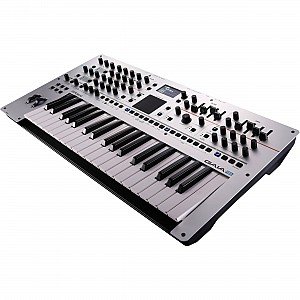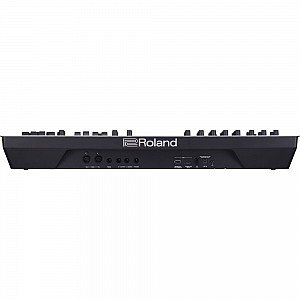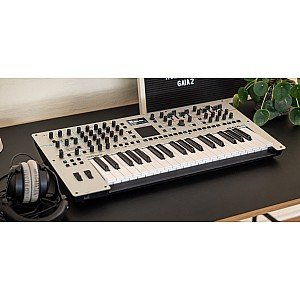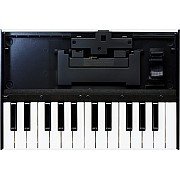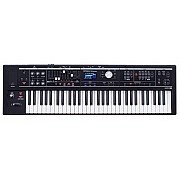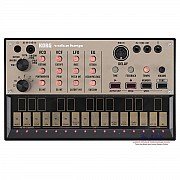 Monday-Friday : 09.00 - 18.00 , Saturday : 09.00 - 15.00 wib
Monday-Friday : 09.00 - 18.00 , Saturday : 09.00 - 15.00 wib -

SECURE STORE
Official shop,Original and Warranty.
-

FAST SHIPPING
WITHIN 1 HOUR *
-

CALL US
021-6501012 / 65306112
-

ADDRESS
JL.SUNTER MAS BARAT 1 BLOK H.9 NO.4 JAKARTA UTARA
Shopping Cart
0 item(s) - Rp.0,00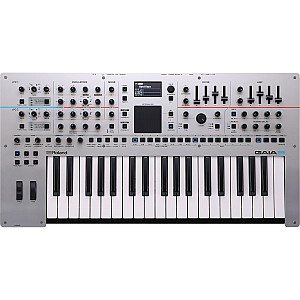
Spesifikasi Roland GAIA-2 37-key Virtual Analog Wavetable Synthesizer
Roland GAIA-2 37-key Virtual Analog Wavetable Synthesizer
Planetary Power and Unbounded Sonic Creation
The original Gaia synthesizer was designed to meld past and future via virtual analog synthesis, all revolving around Roland’s iconic SH-101. Now, its long-awaited successor brims with cutting-edge tech to deliver a whole new world of sonic possibilities: Enter Gaia 2, a 37-key polyphonic synthesizer armed with state-of-the-art virtual analog sound engines with three immensely powerful oscillators comprising multiple waveforms and noise options, as well as wavetable synthesis and deep interoperative functions like cross modulation, oscillator syncing, ring modulation, and more. Gaia 2 also introduces the Motional Pad for endlessly reconfigurable touch-based, dual-axis modulation. If you're a Synthesists, you are smitten with the scope of sound-shaping opportunities, from 250+ diverse presets and dozens of multi-FX to the suite of heritage Roland sonics available from the moment you boot up Gaia 2, like the preinstalled SH-101 Model Expansion and iconic JUNO chorus effects.
Oscillating wildly through new, hybridized terrains
Every ounce of sound Gaia 2 produces starts with its powerful, versatile 3-oscillator architecture, fueling the virtual analog engines of oscillators two and three for a slew of sounds that range from iconic to uncharted, futuristic territories. Each of these oscillators boasts five waveforms, including super saw, triangle, and square options, as well as five noise waveforms. On the other hand, oscillator one introduces a dedicated wavetable option with 63 waveforms that you can freely jump and morph your way around, from evocative slow-burns to rapid, punctuated shifts. Wave position, phase, and shape can even be modulated with the two-axis Motional Pad for direct control of your sound. Both virtual analog engines include dedicated wave-shaping controls that, coupled with the oscillator mixer, allow for an impressive variety of sound-shaping possibilities. Moreover, oscillator sync, cross-modulation, and ring modulation are on tap to explore intense timbres, thundering lows, and dynamic tones. You’ve also got access to an AD envelope that can be routed to numerous destinations across all three oscillators, resulting in expressive, voltaic sounds that can stack to extravagant heights thanks to the 3-oscillator per-voice polyphony.
Modern tone crafting and reactive synthesis
Both virtual analog engines include dedicated wave-shaping controls that, coupled with the oscillator mixer, allow for an impressive variety of sound-shaping possibilities. Moreover, oscillator sync, cross-modulation, and ring modulation are on tap to explore intense timbres, thundering lows, and dynamic tones. You’ve also got access to an AD envelope that can be routed to numerous destinations across all three oscillators, resulting in expressive, voltaic sounds that can stack to extravagant heights thanks to the 3-oscillator per-voice polyphony. Looking for more ways to sound out? A pair of LFOs can each be assigned to up to four parameters attached to any of the knobs or sliders, save for click-dials, while tempo-syncable rates and depth are individually managed. This functionality goes double for the waveforms that include six options: four wave shapes, a randomizer, and a programmable step wave.

Dynamic textures from vintage to uncharted
Thanks to Roland’s masterful sound-modeling technology, Gaia 2 bristles with vintage character that’s rife for reimagining with the synth’s contemporary tool kit. Texturization options comprise 53 multi-effects that are navigated from the display screen. Reverbs and delays come in seven distinct shades that can be readily refined. Meanwhile, the vaunted character of the infamous JUNO chorus effects is seamlessly toggled from a single-button control, incorporating all three styles with multiple permutations that total nine chorus choices. You can even rearrange the sound path of the multi-FX, reverb/delay, and chorus for deep sound crafting.
Dedicated amp and filter sections feature individuated ADSR sliders, with the latter capable of key-following and envelope-depth management that can be uniquely attenuated. Additional filtering is available via the multimode filter system that not only painlessly toggles between low-, band-, and highpass options, but also features a triptych of variable slopes: -12dB/Oct, -18dB/Oct, or -24dB/Oct. You’ve even got a dedicated filter drive knob for when you need to supplement your sound with some gritty textures.
Features:
- GAIA-2 hybrid engine design comprises twin virtual analog oscillators and a dedicated wavetable oscillator for versatile sonic sculpting from iconic analog to futuristic
- 1-to-1 interface design means intuitive, direct control of your sound, minus the menu-diving
- Preinstalled SH-101 Model Expansion provides instant access to the full scope of the iconic synth with uncompromising accuracy
- Wavetable oscillator includes 63 waveforms through which you can seamlessly morph for slow to break-neck speeds of evocative expression
- Virtual analog oscillators include sine, triangle, saw, square, and super saw waveforms, as well as 5 noise waves and wave shaping for flexible sound design
- Extensive modulation includes wave position, phase modulation, and shaping modulation for wavetable synthesis, with oscillator sync, ring mod, and 2 cross-mod options for OSC 2 and 3
- Motional Pad lets you seize your sound with 2-axis dynamic modulation that’s freely assignable to virtually any parameter, including FX, modulation, oscillator controls, and more
- Additional navigation features with Motional Pad include motion recording and recall, as well as drag-pointer functionality with the OLED menu display
- AD envelope provides multiple destinations, including pitch, oscillator shapes, and modulation vectors for dynamic, reactive tones
- Powerful multimode ADSR filter includes LPF, BPF, and HPF options and 3 slope choices, each of which can be individually toggled for detailed sound-shaping
- ADSR sliders, filter drive, envelope depth, and key-following can all be attenuated to hone and refine your patches
- Dedicated ADSR amp provides detailed global audio output control
- Dual LFOs comprise 6 shaping options for extensive modulation possibilities: 4 waveforms, one randomization mode, and one programmable step wave
- Each LFO can be assigned upwards of 4 parameters, capable of controlling virtually anything attenuated via knob or slider, eliciting expressive, evolving sonics
- 52 multi-FX can be instantly toggled for vast texturizing opportunities, including Lo-Fi, distortions, phasers, and more
- Dedicated Chorus section comprises nine modes across 3 styles, including the iconic JUNO chorus for vintage-tinged dimensional expansion
- Reverb/delay suite includes 7 flavors with fine controls to sculpt your space, from subtle to cavernous
- Additional performance features, like mono, legato, portamento, unison, chord memory, hold functionality, and velocity sensitivity can be instantly toggled to easily bolster any part
- Powerful 64-step sequencer is capable of flexible recording and composition, with 8 notes per step and 4 controls, alongside real-time, step, and TR-REC recording options
- Random pattern generator and probability functions introduce dynamic dimensions to sequencing to inspire new parts or spice up performances
- 5-mode arpeggiator ensures extensive rhythmic exploration, including 16 scale variations
- USB-A port provides MIDI connectivity and external memory accommodation
- USB-C Class Compliant port functions as a Roland driver for audio and MIDI, as well as providing bus power when needed (AC adapter included)
- 5-pin DIN MIDI I/O provides flexible control options with additional AIRA LINK compatibility for deep and expansive interoperative possibilities with virtually any setup
- Front-mounted 3.5mm headphone jack and rear-mounted 1/4-inch stereo output pair ensure you’re sounding out on your terms
- 1/4-inch pedal jack accommodates any number of pedal switches, expression pedals, and more (sold separately)
- Roland Cloud compatibility means infinite opportunities to shape and meld sounds from iconic Roland synths throughout the years, instantly accessible with Gaia 2 (subscription sold separately)
- Type: Keyboard Synth
- Sound Engine: Wavetable and Virtual Analog Engines
- Analog/Digital: Digital
- Number of Keys: 37
- Type of Keys: Full-size
- Other Controllers: Pitchbend, Mod wheel
- Pads: X-Y motion pad
- Polyphony: 22 Notes (patch dependant)
- Number of Presets: 256 x Preset, 512 x User
- Oscillators: 1 x Wavetable, 2 x Virtual Analog
- Waveforms: Sine, Triangle, Saw, Square, Super Saw
- LFO: 2 x LFO (Triange, Sine, Saw, Random, Step)
- Filter: Lowpass, Bandpass, Highpass
- Envelope Generator: 2 x EG (attack, decay, sustain, release)
- Effects Types: 53 x multi-effects, 7 x Reverb/Delay, 9 x Chorus
- Arpeggiator: 5 Modes
- Sequencer: 8-track | 64-step, Real-time/step recording
- Audio Outputs: 2 x 1/4" TS (L/Mono, R)
- Headphones: 1 x 1/4" TRS, 1 x 1/8" TRS
- USB: 1 x Type-A (Memory, MIDI), 1 x Type-C (computer, 5V)
- MIDI I/O: In, Out
- Pedal Inputs: 1 x 1/4" TRS
- Expansion: Software Modal Expansions
- Software: Roland Cloud
- OS Requirements - Mac: MacOS 10.14 or later
- OS Requirements - PC: Windows 10 or later
- Power Source: 12V DC power supply (included)
- Height: 3.625"
- Width: 25.81"
- Depth: 13.25"
- Weight: 9.75 lbs.
- Manufacturer Part Number: GAIA-2
Roland GAIA-2 37-key Virtual Analog Wavetable Synthesizer
Spesifikasi Roland GAIA-2 37-key Virtual Analog Wavetable Synthesizer
Roland GAIA-2 37-key Virtual Analog Wavetable Synthesizer
Planetary Power and Unbounded Sonic Creation
The original Gaia synthesizer was designed to meld past and future via virtual analog synthesis, all revolving around Roland’s iconic SH-101. Now, its long-awaited successor brims with cutting-edge tech to deliver a whole new world of sonic possibilities: Enter Gaia 2, a 37-key polyphonic synthesizer armed with state-of-the-art virtual analog sound engines with three immensely powerful oscillators comprising multiple waveforms and noise options, as well as wavetable synthesis and deep interoperative functions like cross modulation, oscillator syncing, ring modulation, and more. Gaia 2 also introduces the Motional Pad for endlessly reconfigurable touch-based, dual-axis modulation. If you're a Synthesists, you are smitten with the scope of sound-shaping opportunities, from 250+ diverse presets and dozens of multi-FX to the suite of heritage Roland sonics available from the moment you boot up Gaia 2, like the preinstalled SH-101 Model Expansion and iconic JUNO chorus effects.
Oscillating wildly through new, hybridized terrains
Every ounce of sound Gaia 2 produces starts with its powerful, versatile 3-oscillator architecture, fueling the virtual analog engines of oscillators two and three for a slew of sounds that range from iconic to uncharted, futuristic territories. Each of these oscillators boasts five waveforms, including super saw, triangle, and square options, as well as five noise waveforms. On the other hand, oscillator one introduces a dedicated wavetable option with 63 waveforms that you can freely jump and morph your way around, from evocative slow-burns to rapid, punctuated shifts. Wave position, phase, and shape can even be modulated with the two-axis Motional Pad for direct control of your sound. Both virtual analog engines include dedicated wave-shaping controls that, coupled with the oscillator mixer, allow for an impressive variety of sound-shaping possibilities. Moreover, oscillator sync, cross-modulation, and ring modulation are on tap to explore intense timbres, thundering lows, and dynamic tones. You’ve also got access to an AD envelope that can be routed to numerous destinations across all three oscillators, resulting in expressive, voltaic sounds that can stack to extravagant heights thanks to the 3-oscillator per-voice polyphony.
Modern tone crafting and reactive synthesis
Both virtual analog engines include dedicated wave-shaping controls that, coupled with the oscillator mixer, allow for an impressive variety of sound-shaping possibilities. Moreover, oscillator sync, cross-modulation, and ring modulation are on tap to explore intense timbres, thundering lows, and dynamic tones. You’ve also got access to an AD envelope that can be routed to numerous destinations across all three oscillators, resulting in expressive, voltaic sounds that can stack to extravagant heights thanks to the 3-oscillator per-voice polyphony. Looking for more ways to sound out? A pair of LFOs can each be assigned to up to four parameters attached to any of the knobs or sliders, save for click-dials, while tempo-syncable rates and depth are individually managed. This functionality goes double for the waveforms that include six options: four wave shapes, a randomizer, and a programmable step wave.

Dynamic textures from vintage to uncharted
Thanks to Roland’s masterful sound-modeling technology, Gaia 2 bristles with vintage character that’s rife for reimagining with the synth’s contemporary tool kit. Texturization options comprise 53 multi-effects that are navigated from the display screen. Reverbs and delays come in seven distinct shades that can be readily refined. Meanwhile, the vaunted character of the infamous JUNO chorus effects is seamlessly toggled from a single-button control, incorporating all three styles with multiple permutations that total nine chorus choices. You can even rearrange the sound path of the multi-FX, reverb/delay, and chorus for deep sound crafting.
Dedicated amp and filter sections feature individuated ADSR sliders, with the latter capable of key-following and envelope-depth management that can be uniquely attenuated. Additional filtering is available via the multimode filter system that not only painlessly toggles between low-, band-, and highpass options, but also features a triptych of variable slopes: -12dB/Oct, -18dB/Oct, or -24dB/Oct. You’ve even got a dedicated filter drive knob for when you need to supplement your sound with some gritty textures.
Features:
- GAIA-2 hybrid engine design comprises twin virtual analog oscillators and a dedicated wavetable oscillator for versatile sonic sculpting from iconic analog to futuristic
- 1-to-1 interface design means intuitive, direct control of your sound, minus the menu-diving
- Preinstalled SH-101 Model Expansion provides instant access to the full scope of the iconic synth with uncompromising accuracy
- Wavetable oscillator includes 63 waveforms through which you can seamlessly morph for slow to break-neck speeds of evocative expression
- Virtual analog oscillators include sine, triangle, saw, square, and super saw waveforms, as well as 5 noise waves and wave shaping for flexible sound design
- Extensive modulation includes wave position, phase modulation, and shaping modulation for wavetable synthesis, with oscillator sync, ring mod, and 2 cross-mod options for OSC 2 and 3
- Motional Pad lets you seize your sound with 2-axis dynamic modulation that’s freely assignable to virtually any parameter, including FX, modulation, oscillator controls, and more
- Additional navigation features with Motional Pad include motion recording and recall, as well as drag-pointer functionality with the OLED menu display
- AD envelope provides multiple destinations, including pitch, oscillator shapes, and modulation vectors for dynamic, reactive tones
- Powerful multimode ADSR filter includes LPF, BPF, and HPF options and 3 slope choices, each of which can be individually toggled for detailed sound-shaping
- ADSR sliders, filter drive, envelope depth, and key-following can all be attenuated to hone and refine your patches
- Dedicated ADSR amp provides detailed global audio output control
- Dual LFOs comprise 6 shaping options for extensive modulation possibilities: 4 waveforms, one randomization mode, and one programmable step wave
- Each LFO can be assigned upwards of 4 parameters, capable of controlling virtually anything attenuated via knob or slider, eliciting expressive, evolving sonics
- 52 multi-FX can be instantly toggled for vast texturizing opportunities, including Lo-Fi, distortions, phasers, and more
- Dedicated Chorus section comprises nine modes across 3 styles, including the iconic JUNO chorus for vintage-tinged dimensional expansion
- Reverb/delay suite includes 7 flavors with fine controls to sculpt your space, from subtle to cavernous
- Additional performance features, like mono, legato, portamento, unison, chord memory, hold functionality, and velocity sensitivity can be instantly toggled to easily bolster any part
- Powerful 64-step sequencer is capable of flexible recording and composition, with 8 notes per step and 4 controls, alongside real-time, step, and TR-REC recording options
- Random pattern generator and probability functions introduce dynamic dimensions to sequencing to inspire new parts or spice up performances
- 5-mode arpeggiator ensures extensive rhythmic exploration, including 16 scale variations
- USB-A port provides MIDI connectivity and external memory accommodation
- USB-C Class Compliant port functions as a Roland driver for audio and MIDI, as well as providing bus power when needed (AC adapter included)
- 5-pin DIN MIDI I/O provides flexible control options with additional AIRA LINK compatibility for deep and expansive interoperative possibilities with virtually any setup
- Front-mounted 3.5mm headphone jack and rear-mounted 1/4-inch stereo output pair ensure you’re sounding out on your terms
- 1/4-inch pedal jack accommodates any number of pedal switches, expression pedals, and more (sold separately)
- Roland Cloud compatibility means infinite opportunities to shape and meld sounds from iconic Roland synths throughout the years, instantly accessible with Gaia 2 (subscription sold separately)
- Type: Keyboard Synth
- Sound Engine: Wavetable and Virtual Analog Engines
- Analog/Digital: Digital
- Number of Keys: 37
- Type of Keys: Full-size
- Other Controllers: Pitchbend, Mod wheel
- Pads: X-Y motion pad
- Polyphony: 22 Notes (patch dependant)
- Number of Presets: 256 x Preset, 512 x User
- Oscillators: 1 x Wavetable, 2 x Virtual Analog
- Waveforms: Sine, Triangle, Saw, Square, Super Saw
- LFO: 2 x LFO (Triange, Sine, Saw, Random, Step)
- Filter: Lowpass, Bandpass, Highpass
- Envelope Generator: 2 x EG (attack, decay, sustain, release)
- Effects Types: 53 x multi-effects, 7 x Reverb/Delay, 9 x Chorus
- Arpeggiator: 5 Modes
- Sequencer: 8-track | 64-step, Real-time/step recording
- Audio Outputs: 2 x 1/4" TS (L/Mono, R)
- Headphones: 1 x 1/4" TRS, 1 x 1/8" TRS
- USB: 1 x Type-A (Memory, MIDI), 1 x Type-C (computer, 5V)
- MIDI I/O: In, Out
- Pedal Inputs: 1 x 1/4" TRS
- Expansion: Software Modal Expansions
- Software: Roland Cloud
- OS Requirements - Mac: MacOS 10.14 or later
- OS Requirements - PC: Windows 10 or later
- Power Source: 12V DC power supply (included)
- Height: 3.625"
- Width: 25.81"
- Depth: 13.25"
- Weight: 9.75 lbs.
- Manufacturer Part Number: GAIA-2
Write a review
Your Name:Your Review:
Note: HTML is not translated!
Rating: Bad Good
Enter the code in the box below:


